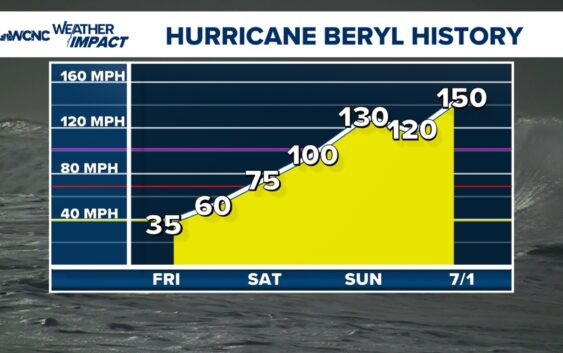- Report: Coastal flooding could threaten 1.4 million homes by midcentury
- Caught on camera | Tornado touches down in Missouri
- Carolina Hurricanes playoff tickets go on sale next week
- Storms kill 6 in the South and Midwest as forecasters warn of catastrophic rains, floods this week
- Weather Impact Alert: Cold front could trigger severe weather in Houston area this weekend | See timeline
Hurricane Beryl rapid intensification process

CHARLOTTE, N.C. — Hurricane Beryl is the first category 4 hurricane on record to develop during the month of June.
Before it strengthened into a named storm, it was a tropical wave between the coast of Africa and the Caribbean. Part of Beryl’s legacy is just how quickly it developed and organized into a tropical depression, then a tropical storm and quickly formed into a hurricane.
For the latest weather alerts, download the WCNC Charlotte mobile app and enable push notifications.
Rapid intensification
Hurricane Beryl underwent a weather phenomenon known as rapid intensification, a process that occurs when a tropical system max sustained winds increase by at least 35 miles per hour within a 24-hour period.
Rapid intensification can pose a much bigger threat to life and property because those in its path will have less time to prepare for the intensity and impacts of the storm.
Warmer than average sea-surface temperatures play a key role in the rapid intensification process. Water temperatures of 80 degrees or warmer can provide a source of high moisture content coupled with low wind shear and decreasing pressure will accelerate the winds causing the hurricane to rapidly develop.
Beryl Landfall
Beryl made landfall on Carriacou Island Monday, July 1, 2024 with max sustained winds of 150 mph. The historic hurricane intensified from a tropical depression to a major hurricane in less than 48 hours. A storm of category intensity can produce catastrophic damage including life-threatening storm surge.
A closer look at tropical activity in June shows Beryl is the only category 4 to form in June. Beryl is historic for intensifying into a category 4 near the southern Caribbean at this stage in the season. In 2005, Hurricane Dennis strengthened into a category 4 storm on July 8.
June Storm Activity
- 83 Tropical Storms
- 22 Category 1
- 11 Category 2
- 4 Category 3
- 1 Category 4
Category 4 hurricanes typically occur later in the season during the month of September, which is around peak hurricane season.
WCNC Charlotte’s Weather IQ YouTube channel gives detailed explainers from the WCNC Charlotte weather meteorologists to help you learn and understand weather, climate and science. Watch previous stories where you can raise your Weather IQ in the YouTube playlist below and subscribe to get updated when new videos are uploaded